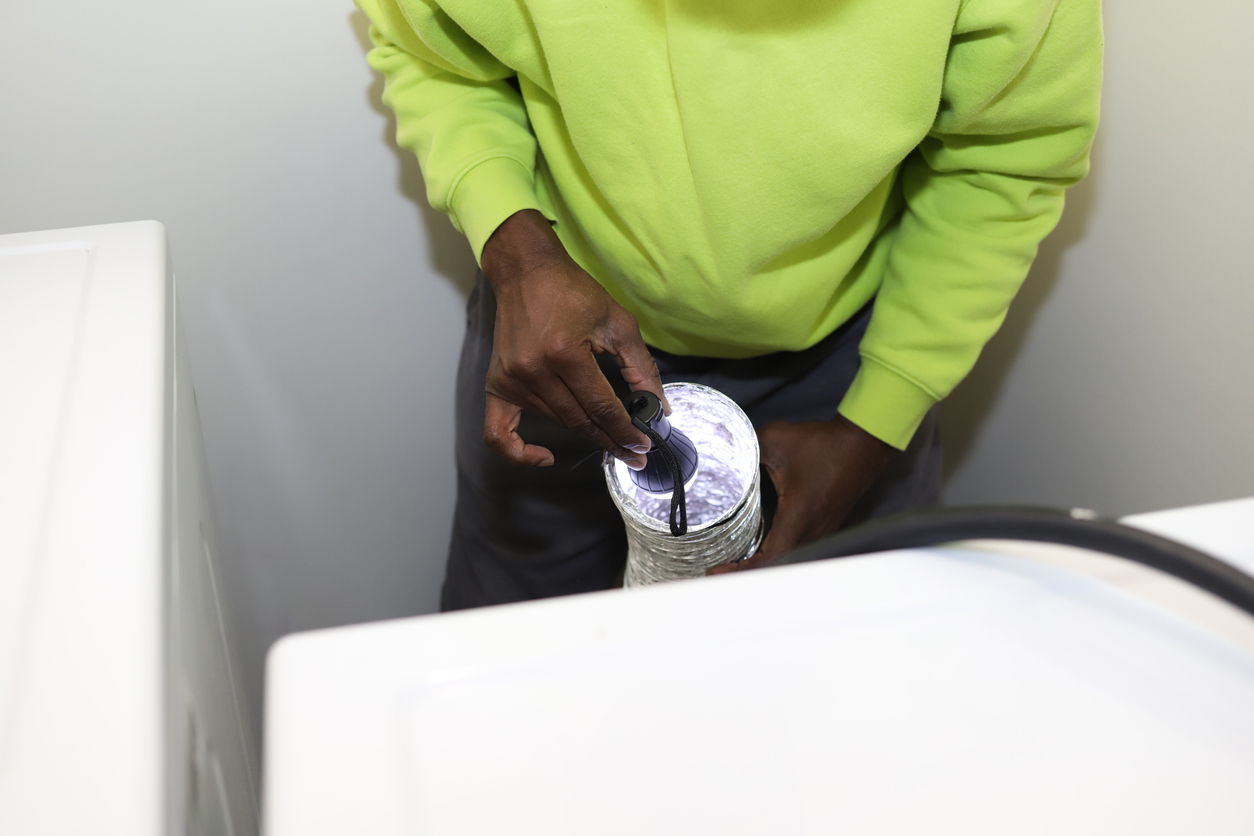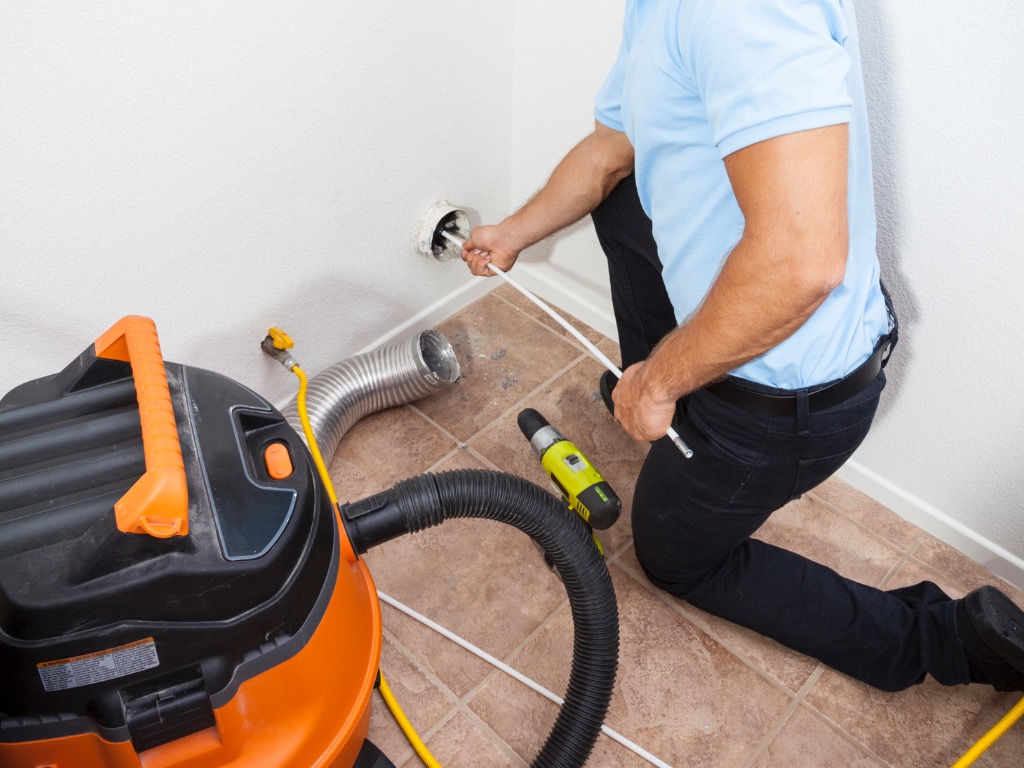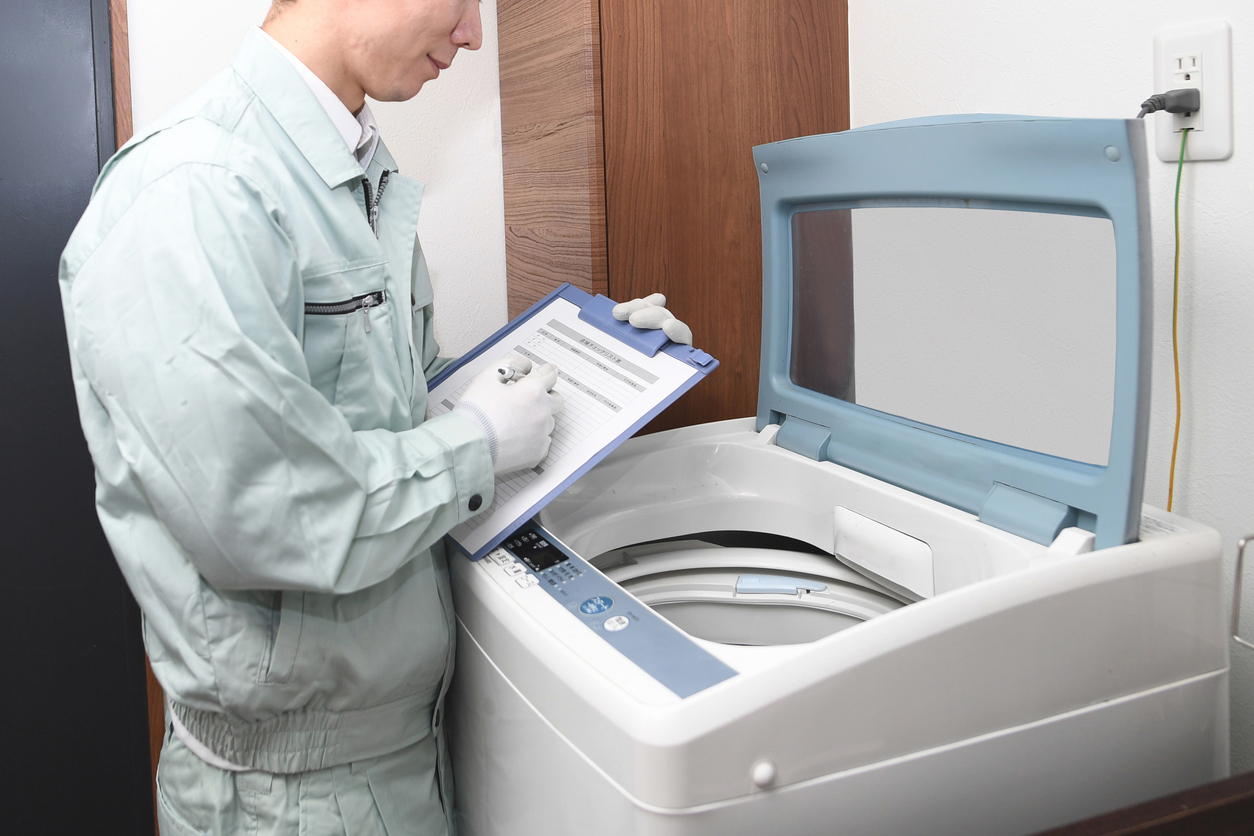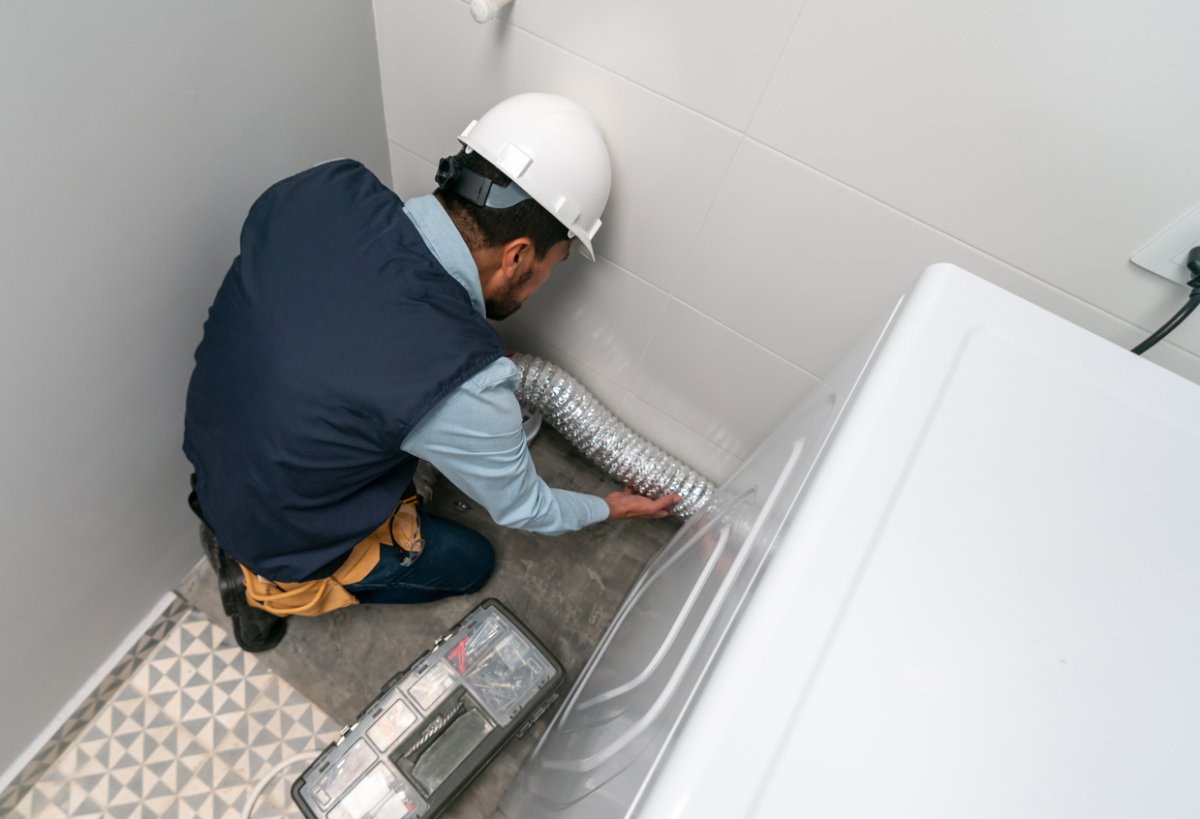We may earn revenue from the products available on this page and participate in affiliate programs. Learn More ›
Highlights
- Most dryer vent installations cost between $80 and $1,000 for labor and materials.
- The length of vent, the material selected, the type of vent, and local labor rates will be the biggest factors in calculating the cost to install a dryer vent.
- Properly installed and regularly cleaned dryer vents perform an important safety role to help prevent accidental fires due to debris buildup—not to mention the adequate removal of carbon monoxide exhaust from a gas dryer.
- Homeowners typically leave dryer vent installation to a qualified professional who is familiar with ensuring the vent is sealed properly, routed efficiently, and ventilating adequately.
Electric or gas dryers have become a staple appliance in most modern homes thanks to their convenient and efficient ability to rapidly dry wet clothing, towels, and other laundry items. It’s the combination of heated airflow and tumbling clothes that make fast work of drying clothes. However, the air inside the dryer needs unobstructed ventilation to the outside to avoid potential fire hazards from a buildup of lint, as well as to prevent other issues. Cracked, broken, or missing dryer vents can lead to moisture accumulation, water damage, mold growth, and sometimes carbon monoxide exposure.
Dryer vent installation costs an average of $80 to $1,000 according to Angi and HomeAdvisor. The broad range in dryer vent prices is due to local labor rates, vent material and length, and the installation location. These and other factors drive the overall cost to install a dryer vent in the home. For example, if the dryer is located directly beside an exterior wall, then dryer vent hose installation or replacement is relatively inexpensive. However, the new dryer vent may need to be installed through the roof, which can increase the cost of installation.

Factors in Calculating Dryer Vent Installation Cost
Before hiring a professional, it’s important for a homeowner to understand the various factors that can impact the cost, such as the dryer vent location, material, type, and length, in addition to local labor rates.
Vent Material
The best dryer vents are typically made out of PVC or plastic, though there are metal dryer vents made of rigid aluminum, galvanized steel, or stainless steel. The type of vent material can affect the cost of the installation, so it’s helpful for homeowners to evaluate which material is ideal for their home before starting this project.
- Metal dryer vents are the most durable option available. This type of vent can last much longer than PVC or plastic vents, though the increased life and durability come at an equally increased cost. Homeowners can expect to pay about $200 to $300 to install metal dryer vents.
- Plastic dryer vents are similar to PVC vents in that they are prone to breaking down after ongoing exposure to high heat and moisture. They tend to outlast PVC vents, though, so they are still worth considering. Plastic dryer vents cost about $150 to $200 to install.
- PVC dryer vents are the least expensive option, ranging from about $100 to $150 to install. However, PVC doesn’t last as long as metal, and since it can become brittle after prolonged exposure to heat, it isn’t the most durable choice.
Vent Type
Another factor to consider is the type of dryer vent. Dryer vents can be differentiated based on the size and rigidity of the product. Dryer vent hoses for tight spaces will have a slimmer or thinner profile to fit the space. Slim dryer vents cost about $100 to $200 to install, while the wider semi-rigid dryer vents cost about $200 to $250.
Semi-rigid dryer vents are one of the most common choices for short dryer vent needs. This type of dryer vent is typically made out of flexible plastic or aluminum that allows the vents to bend around or through obstacles.
Rigid dryer vents are another available option and cost around $250 to $300 to install. As the name implies, this type of dryer vent is made up of straight, rigid ducts and joints that carry the exhaust from the dryer to the exterior of the home.
Vent Length
After determining the best material and type of dryer vent, the installer will need to measure how long the vent hose should be to reach the exterior of the house. The cost to install a dryer vent hose ranges from about $12.50 to $15 per linear foot. Most houses need about 8 feet of dryer hose, which costs about $100 to $120, while the maximum recommended 35-foot length would cost about $280 to $300.
Professional installers will keep in mind several key dryer safety regulations to prevent future fire hazards. Dryer vent ducts are not to exceed 35 feet in length from the dryer to the wall or end of the roof. Additionally, the maximum length of the duct needs to subtract 2.5 feet if there’s a 45-degree bend since airflow is restricted around corners. If there’s a 90-degree bend in the ductwork, then 5 feet should be subtracted.
Labor
The labor involved for installing a dryer vent will generally range in cost from about $20 to $35 per hour. A standard installation project will only take about 2 to 4 hours, so the labor cost will work out to about $40 to $140 before the cost of materials. However, if the job is not a standard installation, then the completion time and cost can increase.
When the contractor comes to assess the home, they will usually provide a quote for the work. This is a great opportunity to discuss how long the job will take, the labor rate, and the installation plan for the project. Homeowners can work with the contractor to determine the best option for installing the new dryer vent and find out the expected labor cost ahead of time to help ensure the job stays on budget.
Installation Location
One of the most important factors to consider for dryer vent installation cost is where the vent will be installed in the house. If the dryer is located right next to an exterior wall, installation is usually cheaper, and the job may even be easy enough for an advanced DIYer to complete. However, a dryer that is positioned in the center of the home will be much more difficult to vent to the outside, which can increase the time and cost of the project.
- Standard wall installation ranges from about $100 to $300 for a professional contractor to complete the job, though the cost can increase by about $50 to $150 per hole if the contractor needs to cut through harder walls such as concrete or brick.
- Basement, slab, or crawl space installations can cost $150 to $300, but if the contractor needs to open a wall to run ductwork, the price can increase to about $500 to $1,000 for installation and necessary repairs.
- Roof installations are generally the most expensive option because the installer may need to run the ductwork through walls, multiple floors, and an attic to get to the exterior of the home. Homeowners will likely pay $1,000 or more if a roof installation is required. In most cases, the installer will opt to find a closer exit point along a wall to reduce costs and improve duct ventilation.
Additional Costs and Considerations
Beyond the initial cost factors, a dryer vent hose installation project can have additional costs depending on certain conditions that may or may not apply. For instance, homeowners can consider the cost differences between an interior and exterior vent, and the difference between a new vent installation or a simple dryer vent replacement. Vent rerouting, customizations, and any add-on features could also increase the cost of the dryer vent hookup.
Interior vs. Exterior Vent
Not all dryer vents lead to the outside of the home. If the dryer is located in a condo, apartment, or a similar location that makes it difficult to run a vent to the outside, then the installer may suggest an inside dryer vent.
- Interior dryer vent installations are great for small spaces where it is nearly impossible to run the dryer vent to the outdoors within the maximum recommended length of 35 feet. This type of dryer vent filters the lint and moisture before releasing the warm air back into the home. It costs about $100 to $175 to install an indoor dryer vent.
- Exterior dryer vent installations are the most common option because they release the heat, lint particles, and moisture to the outside of the home. A major difference between gas vs. electric dryers is the exit point for the vent. Gas dryers require an exterior dryer vent in order to release the carbon monoxide exhaust outdoors. Otherwise, the carbon monoxide can build up inside, putting the residents of the home at risk. This dryer vent installation cost is about $150 to $300 on average.
New vs. Replacement
A dryer vent installation project usually happens during new-home construction, dryer relocation, and ductwork replacement jobs. The cost of the project can vary significantly depending on whether the installer needs to put in a new dryer vent or if they are just replacing an existing dryer vent.
- New dryer vent installations cost about $150 to $300 to run the vent outdoors, while an indoor vent installation will cost about $100 to $175. The cost of this job is higher than that of a replacement job because the installer needs to plan and cut holes for the ductwork.
- Replacement dryer vent installations only cost about $20 to $35 per hour for labor and $10 to $30 for materials. However, some professionals will also charge a minimum service fee on smaller jobs, so if homeowners only need a replacement dryer vent, it’s a good idea to ask if there’s a minimum charge.
Vent Rerouting
Sometimes the homeowner may need or want to move the location of the dryer. A professional installer can reroute the ductwork for the dryer vent quite easily. Generally, this project will cost about as much as installing or replacing a dryer vent, with an average cost of about $80 to $200 for the project.
However, if the contractor determines that an outlet needs to be moved or a new electrical outlet for the dryer needs to be installed, this can increase the cost by $200 or more. Similarly, if the contractor needs to install a gas line to accommodate the new location of the dryer, this can add to the overall cost of the project. Homeowners often spend about $200 to $800 for a new gas line installation.
Customizations and Add-Ons
There are several customizations and add-ons the homeowner can invest in during the installation project or even after the dryer vent has been installed. One option is to put in an exhaust fan to boost airflow through the dryer vent. This addition is useful for homes with long dryer vents to prevent lint, dust, and other debris from settling and building up in the ductwork.
Some homeowners prefer to add a heat diverter to the dryer to direct the heat from the appliance back into the home. This customization feature is only suitable for electric dryers, but it can reduce heat loss in the winter and help heat the laundry area.
Another helpful add-on is a vent alarm. This device helps prevent fires by detecting restricted airflow in the ventilation system. If the alarm goes off, then it’s important to clean out the ductwork as soon as possible. Dryer vent cleaning costs average $139 and are worth it to prevent a house fire. Finally, plastic or metal vent guards are also useful for keeping pests out of the dryer vent.
| Dryer Vent Add-Ons | Average Cost |
| Dryer vent alarm | $20 to $45 each |
| Exhaust fan | $200 to $400 each |
| Heat diverter | $7 to $18 each |
| Metal vent guard | $35 to $40 each |
| Plastic vent guard | $7 to $15 each |
| Vent cleaning | $80 to $185 (materials and labor) |

Types of Dryer Vents
Knowing the types of dryer vents available can help homeowners decide which vent is best for their needs. This information is also useful when trying to put together a budget for the project. Homeowners can choose from three dryer vent types including rigid, semi-rigid, and slim.
| Dryer Vent Type | Average Cost |
| Rigid | $250 to $300 |
| Semi-rigid | $200 to $250 |
| Slim | $100 to $200 |
Rigid
The most durable option is rigid dryer venting. This type of dryer vent is generally made with rigid plastic or metal ducts that run straight through the floors, walls, or ceiling. The ductwork can change direction with the aid of rigid joints, similar to HVAC ductwork. The ducts carry air from the dryer to the exterior of the home to release the exhaust outdoors.
While rigid dryer vents are the most durable choice, they are also the most expensive up front. Homeowners who are planning a dryer vent installation project can expect to pay about $250 to $300 for rigid dryer vents. Finally, the longer the vent run, the more costly the job.
Semi-Rigid
Just one step down in terms of durability from rigid dryer vents are semi-rigid vents. These vents are designed for flexibility and convenient installation. The semi-rigid ductwork is typically made of aluminum, PVC, or flexible plastic, allowing the installer to bend the dryer vents to fit around and through various obstacles in the home.
Homeowners who are interested in installing semi-rigid dryer vents will likely pay about $200 to $250 for this job. The flexible ductwork can reduce the time that it takes to complete this installation and may also provide a suitable option for decreasing the length of the vent run. This can have the added effect of lowering the overall cost of the installation by reducing the cost of labor and materials.
Slim
Slim dryer vents are essential when the walls, floors, or ceilings do not have a lot of space for a new ductwork run. This type of dryer vent has a slim or flat profile that fits comfortably into tight spaces throughout the home, allowing the installer to complete the dryer vent installation without negatively impacting any other systems in the house.
Additionally, if a slim dryer vent can fit inside the wall, then the installer may be able to avoid cutting open the wall, which reduces the cost of repairs. Homeowners usually pay about $100 to $200 for a slim dryer vent installation. However, it’s also important to note that the slim profile will become clogged with lint, dust, and other debris faster than a standard vent, so homeowners can use a one of the best dryer vent cleaning kits frequently to reduce the risk of fire.
Benefits of Installing a Dryer Vent
There are many reasons to install a dryer vent. The most obvious is that a dryer is designed to function optimally with a dryer vent. When a dryer vent is not installed or the dryer is using a broken, cracked, or loose dryer vent, then it can reduce the efficiency of the appliance. More importantly, the lack of a dryer vent can increase the risk of fire, mold growth, and carbon monoxide exposure.
Increased Dryer Efficiency
A good reason to install a new dryer vent is to increase the overall efficiency of the dryer. Cracked, loose, leaky, or clogged dryer vents prevent the dryer from expelling the air effectively to the outside of the home. This causes the dryer to work harder than necessary, reducing the efficiency of the appliance.
Even if only the dryer vent tubing needs to be replaced, this can be enough to boost the efficiency of the appliance while reducing the cost to operate the dryer. Additionally, this fix can help the dryer to dry clothes faster and more efficiently by ensuring that the airflow is quickly and effectively directed through the proper channels.
Decreased Fire Risk
The drying process naturally allows lint, dust, and other debris to be released into the dryer vent. Most of this debris should be trapped in the appropriately named lint trap, which is essentially a screen that can be removed and emptied after each cycle. However, a small portion of the lint, dust, and other debris may slip through the lint trap and into the dryer vent.
Old dryer vents can have lint, hair, and other flammable materials built up on the inside of the ductwork. The longer this debris accumulates, the higher the risk of a fire starting due to the heat of the dryer. Homeowners are encouraged to learn how to clean the dryer vent to reduce this risk, but it’s also a good idea to completely replace the dryer vent if it has become too clogged with debris over the years.
Decreased Mold Growth
One of the main reasons to have a functional dryer vent is to carry hot air from the dryer to the exterior of the home. If the existing dryer vent is cracked, loose, or otherwise leaking air into the home, this can increase the surrounding temperature and bring a risk of mold and mildew growth. If mold growth is suspected, homeowners will want to speak with a professional from one of the best mold removal company such as ServiceMaster Restore or ServPro to remediate the problem.
However, the situation can be significantly worse if the moisture is being released unknowingly inside the floors, walls, or ceilings. The enclosed space will work as an incubator, increasing the spread of toxic mold throughout the home. To avoid this issue, replace old, worn, or broken dryer vents with a new dryer vent installation.
Carbon Monoxide Expulsion
Electric dryers do not produce carbon monoxide, so if the home has an electric dryer, then carbon monoxide expulsion is not a priority. However, if the home uses a gas dryer, then it is essential to ensure that the dryer vent is in good condition. Otherwise, the dryer may release carbon monoxide gas into the home with every use.
Carbon monoxide is a colorless and odorless gas that can go completely unnoticed without a working carbon monoxide detector. As the gas escapes the dryer vent, it will build up in the house, putting residents of the home in danger. Homeowners can prevent this risk by installing a new dryer vent or hiring the best dryer vent cleaning service (such as Window Gang or Stanley Steemer) if it is still in good condition.
Dryer Vent Installation: DIY vs. Hiring a Professional
DIY dryer vent installation is possible for advanced DIYers if the dryer is located next to an exterior wall and they have all the tools necessary to install a dryer vent kit. This simpler positioning is the easiest installation job of all to get the short stretch of vent hose from the dryer to the exterior. As long as the DIYer has significant experience drilling through exterior walls and sealing the gaps to prevent moisture and pest problems, then they may be successful at this project.
However, most homeowners prefer to leave dryer vent installation to a professional installer. This is also the most common choice for new construction when all mechanical and electrical jobs are subcontracted out. A professional HVAC contractor can install the dryer vent in a wall, put in a floor dryer vent, or even run the dryer vent up through the roof of the home.
Experienced installers are familiar with the best type of vent and ductwork to use in the homeowner’s area and within their house. They also have the knowledge to run the vent efficiently and safely to avoid as many obstructions as possible while ensuring it’s properly sealed and attached. Since the safety of the home’s occupants is on the line, dryer vent installation is not a job to take lightly.
How to Save Money on Dryer Vent Installation Cost
The cost of replacing a dryer vent can be as low as $80, but it can range up to $1,000 depending on the location of the dryer, the dryer vent material, the dryer vent type, and the difficulty of the installation. With this in mind, homeowners often look for ways to reduce the overall dryer vent installation cost.
- Research several installation professionals. One of the best ways to save on a dryer vent installation is to shop around. Homeowners can speak with at least three reputable installation professionals to get the best price and value.
- Change the location of the dryer. If the homeowner is still in the planning stages for a new house, they may want to consider moving the dryer to an alternate location in the home if it’s currently located in the center. Placing dryers near exterior walls can reduce the difficulty and cost of the dryer vent installation.
- Select low-cost dryer vent options. A slim PVC dryer vent is one of the more cost-effective choices, though it won’t last as long as a metal vent. Reducing the cost of the project by choosing an inexpensive dryer vent material and type is a viable option to help homeowners save on up-front costs.

Questions to Ask About Dryer Vent Installation
Homeowners who take the time to learn more about the appliances and home systems that keep the home functioning properly are better informed when they need to hire a professional. Similarly, when hiring a professional contractor, it’s recommended to research the company, workers, and past projects to get a better idea of the level of skill, professionalism, and quality of work to expect. Dryer vent service technicians can answer many questions to help homeowners feel confident.
- Are you licensed, bonded, and insured?
- What is your professional background and experience?
- Have you completed similar dryer vent installation projects?
- Can you provide a list of referrals from past clients?
- Will you handle permit acquisition if permits are required?
- What is the expected timeline for this job?
- What is your work schedule?
- Will you be using any subcontractors for this work?
- What are your payment terms?
- Do you offer any warranties or guarantees on the work or materials?
- What steps will you take to protect my property?
- Do I need to clean my dryer first?
- What type of dryer vent do you suggest?
- Will the dryer be vented to the outside?
- How will you get the dryer vent outside?
- Where will the exterior vent be located?
- Is there another option that could be more cost-effective?
- What add-ons would you recommend for my house?
FAQs
When making changes to an existing appliance or planning a new renovation project for the home, it’s important for homeowners to have a basic understanding of the steps and costs involved with the job.
Q. Who installs dryer vents?
Homeowners may wonder who installs dryer vents from among all the different types of service professionals. Typically, homeowners will rely on a general contractor for this work for new construction, but they can also hire HVAC technicians on their own. It’s also possible that carpenters, some roofers, and some plumbing professionals can install a dryer vent depending on where it’s being installed.
Q. How much space is needed behind a dryer?
Ideally, there should be at least 6 inches of clearance between the dryer and the wall. If the dryer is in a closet, then there should also be at least 1 inch of space between the sides of the dryer and the walls.
Sources: Angi, HomeAdvisor, HomeGuide


